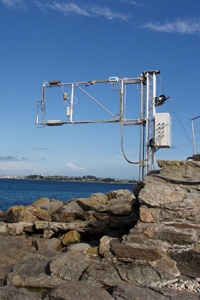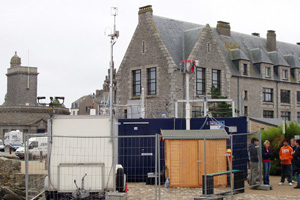RHaMBLe Project-Roscoff
WP 3 Intensive coastal study of iodine-mediated particle formation
Aims
Characterise particle formation and precursor species concentration and fluxes at a coastal location and provide a dataset for validation and testing of a particle nucleation process model.
Rationale
Coastal ultrafine particle formation research is mainly motivated by observations at Mace Head Atmospheric Research Station (MHARS) on the west coast of Ireland. Observations at MHARS have characterised the phenomenon (O’Dowd et al., 1999, 2002) and laboratory investigations have clarified the mechanism (Jimenez et al., 2002, O’Dowd et al., 2002, McFiggans et al., 2004, Saiz-Lopez et al., 2005). The phenomenon is associated with infralittoral macroalgal exposure at daytime low tide and iodine containing compound emission and subsequent photochemistry.
However, four outstanding questions remain:
i) how do other coastal locations compare with MHARS?
ii) how does the flux of new particles relate to the macroalgal iodine atom flux?
iii) what are the local, regional and global implications of coastal new particle formation? and
iv) can the coastal particle formation mechanism lead to significant remote MBL particle formation?
This workpackage will directly address i) and ii) above and will provide data to answer iii) and iv) by linkage to other funded activities. It is proposed to investigate particle formation at an alternative coastal location with state-of-the-art instrumentation probing iodine precursor compounds, their fluxes and photochemistry alongside ultrafine particle formation and evolution. The UK community is uniquely capable of probing the coupled multiphase processes due to the ability to determine the precursor compounds in the field at atmospheric concentrations with simultaneous ultrafine aerosol characterisation. Low tide emissions into the atmosphere include molecular iodine (I2) and volatile organic iodine compounds (VOICs) such as diiodomethane (CH2I2). Iodine monoxide (IO) resulting from their photooxidation self-reacts to form iodine dioxide (OIO). It is thought that these react to yield higher oxides, leading to cluster formation and particle nucleation.
Description

July / August 2006, Roscoff. Ultrafine particle precursors will be measured on a range of spatial scales and the aerosol formation process characterised. Relaxed Eddy Accumulation (REA) systems based on a design developed at Manchester (Nemitz et al., 2001) will be used to determine the coastal halocarbons and I2 fluxes from the infralittoral zone. An eddy correlation system will be used to measure ozone deposition flux and ultrafine particle emission flux over the same footprint to mechanistically relate the ozone deposition, iodine compound emission and the formation of the new particles. The chosen site, Roscoff in Brittany, is known to have dense infralittoral macroalgal coverage. BL long path DOAS measurements of elevated IO concentrations across the Brittany coastline (Peters et al., 2005) provides evidence for active iodine chemistry. Long-path boundary layer DOAS will be deployed for isolating reactive iodine chemistry source region and performing measurements of I2, IO, OIO as well as NO3 and BrO. The DOAS will switch between a long path (8 – 10 km) and a short path (200 – 400 m) in order to obtain spatial information for each species. Broadband Cavity Ringdown Spectroscopy (BBCRDS) in situ point OIO measurement (Bitter et al., 2005) and Broadband Cavity Enhanced Absorption Spectrometer (BBCEAS) measurement of in situ I2, OIO and IO above seaweed exposed at low tide will be carried out (Ball et al., 2004). An additional cell in the existing FAGE instrument will be developed and deployed for in situ measurement of IO. These high time-resolution, point measurements will be used to corroborate the spatial information from the dual path DOAS. Full physical aerosol characterisation (size distributions from 3nm to 30?m, hygroscopicity) will be carried out. Spectral radiometry will be used to provide atomic iodine source strength quantification from I2 and iodocarbon precursors and for constraint of photochemistry modelling in the linked external activities..
Delivers
Characterisation of coastal particle formation quantification linked to gas phase precursor photochemistry. Observational determination of the relationship between iodine precursor flux and new particle formation. Data for use in particle nucleation and global implication modelling.
